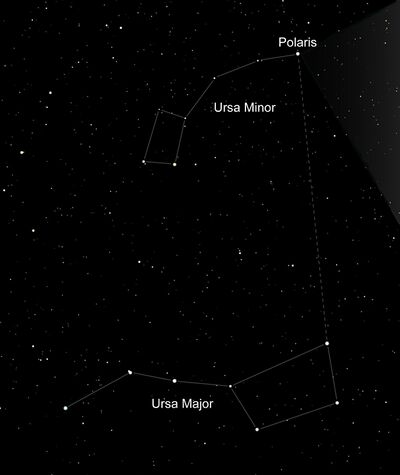Ursa Major: Difference between revisions
Pat Palmer (talk | contribs) mNo edit summary |
Pat Palmer (talk | contribs) m (linking to Ursa Minor) |
||
| Line 3: | Line 3: | ||
'''Ursa Major''', or the '''Great Bear''', is a [[constellation]] in the northern [[sky]]. Its brightest stars are also known as the Big Dipper (in American English) and the Plough (in British English). | '''Ursa Major''', or the '''Great Bear''', is a [[constellation]] in the northern [[sky]]. Its brightest stars are also known as the Big Dipper (in American English) and the Plough (in British English). | ||
Constellations ''Ursa major'' (the "Big Dipper") and ''Ursa minor'' (the "Little Dipper") with Polaris, the North Star, are usually spotted together. Children the world over are taught to find the North Star (which hangs over the North Pole) by means of these two easy-to-spot constellations. The Big Dipper's outer lip points to the North Star, which is at the end of the handle of the Little Dipper. In the course of one night, only the North Star appears unmoving, while all the other stars appear to revolve part-way around it. The other stars revolve all the way around the North Star in approximately one 24-hour day (one rotation of the earth). | Constellations ''Ursa major'' (the "Big Dipper") and ''[[Ursa Minor|Ursa minor]]'' (the "Little Dipper") with Polaris, the North Star, are usually spotted together. Children the world over are taught to find the North Star (which hangs over the North Pole) by means of these two easy-to-spot constellations. The Big Dipper's outer lip points to the North Star, which is at the end of the handle of the Little Dipper. In the course of one night, only the North Star appears unmoving, while all the other stars appear to revolve part-way around it. The other stars revolve all the way around the North Star in approximately one 24-hour day (one rotation of the earth). | ||
{{Infobox Constellation | {{Infobox Constellation | ||
Revision as of 15:53, 12 June 2022
Ursa Major, or the Great Bear, is a constellation in the northern sky. Its brightest stars are also known as the Big Dipper (in American English) and the Plough (in British English).
Constellations Ursa major (the "Big Dipper") and Ursa minor (the "Little Dipper") with Polaris, the North Star, are usually spotted together. Children the world over are taught to find the North Star (which hangs over the North Pole) by means of these two easy-to-spot constellations. The Big Dipper's outer lip points to the North Star, which is at the end of the handle of the Little Dipper. In the course of one night, only the North Star appears unmoving, while all the other stars appear to revolve part-way around it. The other stars revolve all the way around the North Star in approximately one 24-hour day (one rotation of the earth).
| Ursa Major | |
|---|---|
| Latin name | Ursa Major |
| Latin genitive | Ursae Majoris |
| International abbreviation | UMa |
| Number of stars | 227 |
| Symbology | Great Bear |
Remarkable objects
History and mythology
Footnotes
| 88 Official Constellations by IAU |
|
Andromeda • Antlia • Apus • Aquarius • Aquila • Ara • Aries • Auriga • Boötes • Caelum • Camelopardalis • Cancer • Canes Venatici • Canis Major • Canis Minor • Capricornus • Carina • Cassiopeia • Centaurus • Cepheus • Cetus • Chamaeleon • Circinus • Columba • Coma Berenices • Corona Australis • Corona Borealis • Corvus • Crater • Crux • Cygnus • Delphinus • Dorado • Draco • Equuleus • Eridanus • Fornax • Gemini • Grus • Hercules • Horologium • Hydra • Hydrus • Indus • Lacerta • Leo • Leo Minor • Lepus • Libra • Lupus • Lynx • Lyra • Mensa • Microscopium • Monoceros • Musca • Norma • Octans • Ophiuchus • Orion • Pavo • Pegasus • Perseus • Phoenix • Pictor • Pisces • Piscis Austrinus • Puppis • Pyxis • Reticulum • Sagitta • Sagittarius • Scorpius • Sculptor • Scutum • Serpens • Sextans • Taurus • Telescopium • Triangulum • Triangulum Australe • Tucana • Ursa Major • Ursa Minor • Vela • Virgo • Volans • Vulpecula |
